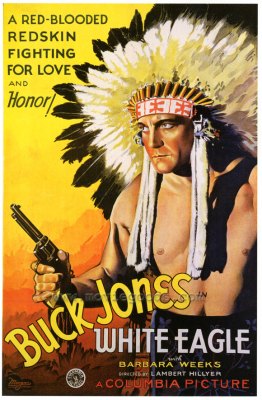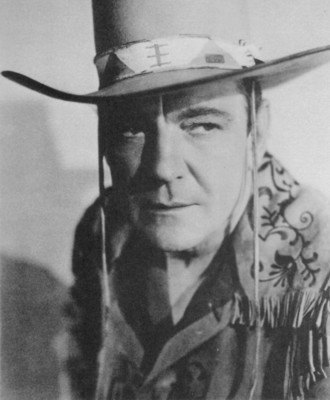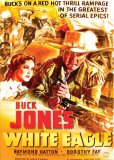| Reviews & Columns |
|
Reviews DVD TV on DVD Blu-ray 4K UHD International DVDs In Theaters Reviews by Studio Video Games Features Collector Series DVDs Easter Egg Database Interviews DVD Talk Radio Feature Articles Columns Anime Talk DVD Savant Horror DVDs The M.O.D. Squad Art House HD Talk Silent DVD
|
DVD Talk Forum |
|
|
| Resources |
|
DVD Price Search Customer Service #'s RCE Info Links |
|
Columns
|
|
|
White Eagle
And then there were Western serials, chapter-plays usually divided into 15 two-reel "episodes," with the first chapter running a bit longer (usually about 30 minutes) and, to save money, a "recap" chapter stuck in there somewhere. Though A-Westerns were typically made for adults, Western serials were strictly for the small fry, Saturday matinee crowd and tended to make even the better Bs appear lavish by comparison. They offered more breathless action than lesser B-Westerns from studios like Monogram, but their stories tended to be more schematic and mechanical. One of the most depressing things about Western serials like Flaming Frontiers is their heavy reliance on stock footage from more elaborate, earlier films. In both this and The Oregon Trail, another Universal-produced, Johnny Mack Brown serial, the filmmakers mine a rich vein of battered silent footage of undetermined origin, working the same clips over and over into practically every chapter.
The 1932 feature film...
...and a still from the 1941 serial
When I saw White Eagle on distributor VCI's list of upcoming releases, I assumed it was the 1932 Buck Jones feature produced at Columbia. As it turned out, it's the same-named 1941 Columbia serial that semi remakes it. The plots are similar though not identical, and probably there's footage from the 1932 version tucked away in there somewhere. I did notice some silent movie stock footage here and there, though not nearly to the extent of those Johnny Mack Brown chapter-plays.
The good news is that White Eagle was remade when it was. As serial fans know, 1941 was just about the peak year for this long-lost form of entertainment. Republic is generally thought to have made the best such films; theirs certainly had the best stunt work and special effects, and in 1941 they ground out what arguably is the best serial ever, Adventures of Captain Marvel, as well as an exceptionally good jungle serial, Jungle Girl, also available from VCI in an unusually good transfer. Both Republic and Columbia's serials went downhill fast after the war, but White Eagle is typical of Columbia's early-'40s chapter-plays. It has the feel of an above-average B-Western feature, and star Buck Jones lends his strong screen presence.
In the 1932 feature, the ringleader of the bad guys is trying to put a stop to the Pony Express by stealing the fastest horses and diverting suspicion by having his henchmen commit crimes (robbing the stage, etc.) disguised as Indians, which in turn sets off an Indian war. Jones plays a Pony Express rider named White Eagle. He's thinks he's an Indian but actually he's the son of an army general. In the 1941 serial, a peace treaty between whites and Indians is threatened by mustached villain Dandy Darnell (James Craven) who has his henchmen, again dressed as Indians, rob the stage, etc. (this may be stock footage from the earlier film) so that the real Indians will be blamed. Half-breed (or not) Pony Express rider White Eagle, accompanied by sidekick Grizzly (Raymond Hatton, doing his best Gabby Hayes impersonation), and later joined by undercover government agent "Poker" Pendleton (Roy Barcroft), is respected by both Indians and whites. He tries to prevent the conflict from escalating into a full-fledged Indian war.
Obviously, the two stories are similar with the serial mainly expanding the 64-minute feature into a nearly five-hour serial. Except for the cheap use of stock footage from other movies, the serialized White Eagle is pleasant enough, though Hatton's highly derivative, unoriginal sidekick is at times painfully unamusing. Almost unavoidably, serials tend to be awfully repetitious, with characters darting from Points A, B, and C and back again in almost every chapter. (In sci-fi and superhero serials, it's always A - the cave/underground hideout of the henchmen; B - the hero's office/headquarters; and C - the mysterious lair of the ringleader.) White Eagle has less of this, offering a more varied selection of familiar Western locales, all within driving distance of Columbia's Hollywood studios. Director James W. Horne is better remembered for his comedies; he was a mainstay at Hal Roach Studios for many years and (co-) directed many of Laurel and Hardy's best comedies, including Way Out West (1937) before turning to serials at the end of his career.
Craggy-faced Jones is just about believable as the half-breed hero. He projects none of the natural warmth of a William Boyd or Roy Rogers, but has a commanding presence. One can only speculate whether Jones might eventually have made a comeback in bigger and better productions, or perhaps eased into character parts in A-Westerns. Sadly, however, Jones died in Boston Coconut Grove fire the following year, an avoidable tragedy that killed nearly 500. Popular legend was that he died after rushing back into the fire to save people but in fact he perished trying to escape the blaze like everyone else.
Video & Audio
Like most serials, White Eagle has fallen into the public domain and quality of VCI's source elements and transfer are about average for this kind of thing. A (presumably) 16mm TV syndication version is sourced; it bears the Screen Gems logo at the end of each episode. The image isn't bad with okay sharpness and contrast but could be better. It's a shame the owners of the original negative, Columbia in this case, don't seem to realize that there are probably enough serial fans out there to justify releasing legit versions of their best chapter-plays. Sony issued a single chapter of the Columbia serial Mysterious Island (1951) on its Sam Katzman boxed set last year, and it looked just great. The Dolby Digital mono audio is okay, less noisy than VCI's Kit Parker releases, which generally use better pre-print material. Thankfully, the 15 chapters are spread over two single-sided (and region-free) discs; earlier VCI serial releases crammed too much material onto a single DVD.
Extra Features
There are no supplements, unless you want to count the Cowboy Montage Video preceding the presentation. It's made up of PD clips of varying quality from other VCI releases. Also included are a few trailers for other VCI titles.
Parting Thoughts
For serial and Buck Jones fans, White Eagle is a nice addition to one's library. It's slightly above average for a Western serial though even most fans of regular A-list Western films will probably want to pass. But for those predisposed to enjoy it, the DVD is Recommended.
Film historian Stuart Galbraith IV's most recent essays appear in Criterion's three-disc Seven Samurai DVD and BCI Eclipse's The Quiet Duel. His audio commentary for Invasion of Astro Monster is now available.
|
| Popular Reviews |
| Sponsored Links |
|
|
| Sponsored Links |
|
|
| Release List | Reviews | Shop | Newsletter | Forum | DVD Giveaways | Blu-Ray | Advertise |
|
Copyright 2024 DVDTalk.com All Rights Reserved. Legal Info, Privacy Policy, Terms of Use,
Manage Preferences,
Your Privacy Choices | |||||||
















